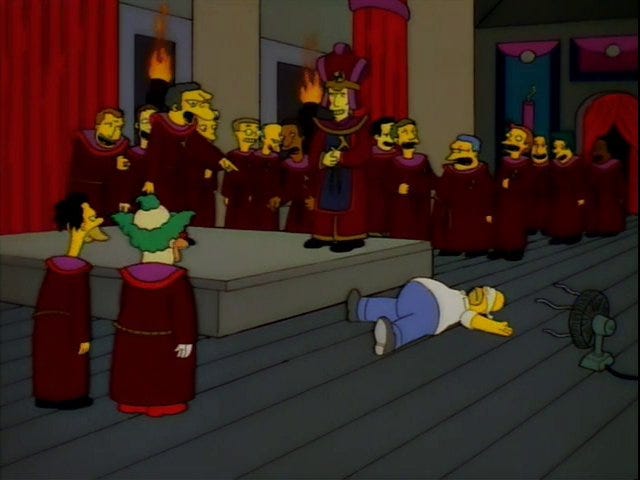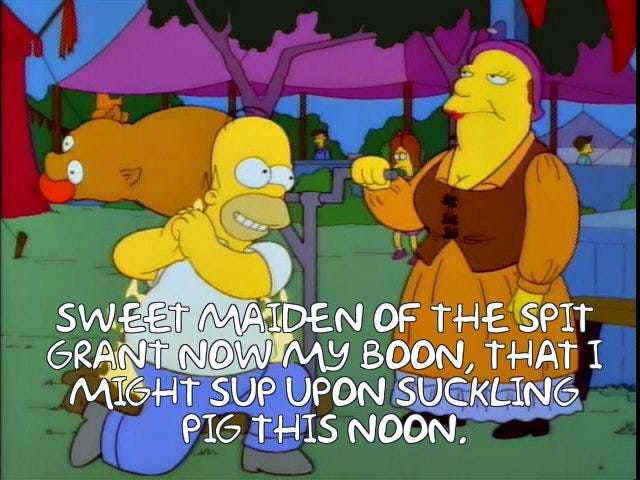Season Six marks the very first time that CLASSIC Scale category scores decline from the previous season. This happens in all but two categories, in fact, which see minimal gains. Accordingly, the season’s average episode score also slips. While S6’s Treehouse of Horror instalment is- by far- the strongest the series has yet to see, only one other episode in the season hits an “Incredible” (9.0 - 9.49) rating.
These are the points I’d lean on to make my case if I were trying to argue that S6 was lacking. But I’m not going to make that case. Because that would be wrong, and stupid.
Season 6 is a masterclass in consistency. Sure, it doesn’t bump any episodes out of my Top 5, but it does dislodge two from the Top 10. And other than one clip show brimming with self-awareness of its own inadequacy, there’s only one episode scored below the A-range: ‘Round Springfield, which has its virtues as a high B+! While S4 still holds the title for most A+ episodes, S6 achieves the highest rate of combined A & A+’s in a season yet (S6: 52% / S5: 50% / S4 36%). Even more impressive, S6 achieves that rate with 25 episodes, as opposed to S4 & S5’s 22 episodes. Consistency.
Could it be the case that the cost of this consistency is less-high highs, exchanged for less-low lows? Maybe. But the best case for each of these three seasons is made from a different angle, and 6’s bragging right is that it emblematizes the show running as a well-oiled machine, churning out Excellent episodes at a spectacular rate.
There are 25 episodes in Season Six of The Simpsons. In this post, you’ll first find the CLASSIC Scale episode score for each, listed from best to worst. Then, the season’s cumulative results. Then, a look at Setting and Irreverence— the two categories that saw improved scores from Season 5.
ICYMI: I explain my method here. This is the master document, containing my up-to-date all-time rankings list.
Incredible (A+)
Treehouse of Horror V
Homer the Great
Excellent (A)
Bart vs. Australia
Who Shot Mr. Burns [Pt. I]
Lisa on Ice
A Star is Burns
Lisa’s Wedding
Fear of Flying
The Springfield Connection
Lemon of Troy
Grandpa vs. Sexual Inadequacy
Two Dozen and One Greyhounds
Itchy & Scratchy Land
Great (A-)
Bart’s Comet
Homer Bad Man
Homie the Clown
Bart of Darkness
Lisa’s Rival
The PTA Disbands
Sideshow Bob Rob
And Maggie Makes 3
Homer vs. Patty and Selma
Bart’s Girlfriend
Very Good (B+)
’Round Springfield
Barely Adequate (C-)
Another Simpson’s Clip Show
Season Six Rankings
Average Category Score + (Change from S5 → S6):
Characters: 8.42 (-0.05)
Laughs: 8.45 (-0.10)
Artistry: 8.50 (-0.01)
Story: 8.25 (-0.01)
Setting: 8.50 (+0.05)
Irreverence: 8.34 (+0.01)
Classic-ness: 8.41 (-0.15)
Total: 8.41 (-0.05)
Compared to Season 4:
Average Category Score— Change from S4 → S6:
Characters: +0.09
Laughs: +0.05
Artistry: +0.15
Story: +0.01
Setting: +0.28
Irreverence: +0.14
Classic-ness: +0.02
Total: 8.30 vs. 8.40 (+0.10)
Average Episode Score: A-
Only Improved Categories:
Irreverence & Setting
Season 6’s Irreverence (+0.01)
As one of 7 categories being used to evaluate The Simpsons, “Irreverence” might seem like a slight stretch— maybe even a stretch I made solely to justify having a cool name for the scale (based on a word that happens to have an “I” in it). If I’m being honest, there’s not not a grain of truth to that.
But for the record, here’s the definition I spelled out in the very first post on this blog:
Irreverence— “lack of respect for people or things that are generally taken seriously.” This is a word that has been used to both praise and hate on The Simpsons. What, if anything, is being lampooned by the episode? Is there some kind of cultural commentary going on in the episode, and how well does this play?
Subtly in the background and loudly in the foreground, the show’s satirical spirit really comes out to play in Season Six. Whether it’s a nurse smoking in an overfilled waiting room or cigarettes for kids:
The hyper-normalization of cartoon violence at Itchy & Scratchy Land or genuine violence in childhood organized sports:
Acid rain:
Jingoistic military stupidity:
Woody Allen’s perversions. More heartbreaking critique of how America treats its elderly. Endless shots at Springfield’s crumbling, dysfunctional education and prison infrastructure (together at last!).
Season 6 is not afraid to say the quiet part loud— in fact, it invented the phrase:
And while the step it takes forward from Season 5 is as small as this scale can register (+0.01), it’s still worth praising the show for continuing to intensify its attacks and integrate its criticisms of everything and everyone from its police, to its politicians, to the most “normal” elements of everyday American life, like what’s on the TV, or the dynamics of the suburban nuclear family. In some episodes, the razor-sharp commentary cuts through as a blip on the radar. In others, it burns through the entire plot. What’s beautiful about The Simpsons is it can do both and everything between.
Season 6 & Setting (+0.05)
“Setting— what does Springfield, or the world outside the Simpson’s home in general, contribute to the episode? Does the episode reveal anything about Springfield’s cultural, social, or political life? If they leave Springfield, where do they go, and what does it do for the episode?”
As the show matures, Springfield shows its multitudes.
Maybe it’s the never-before-mentioned hyper-conservative AM radio host Birch Barlow’s radio show telling us that Springfield is defined by the bats in its library, Mrs. McFirley’s compost heap, and its 6-term Mayor— leading, of course, to the town being hoodwinked into electing local supervillain Sideshow Bob (with the help of serious electoral fraud, of course). Or, it’s learning that the elementary school’s assembly hall was named “Butthead Memorial Auditorium” by the students. Could be the existence of the Stonecutters and their hall. Perhaps the one-off plot-hole-fillers like the town having a single escape route in Bart’s Comet:
Or that other burning bridge, outside the power plant when Homer quits:
Regardless, the lesson to learn is that Springfield has the capacity to add the punch to whatever line a joke requires. On a punishingly hot day, the Chili Truck driver can roll by hawking “Boilin’ Hot Texas Style Ginger Ale.” When we need more jokes about underfunded schools, there’s a historic Fort Springfield to deny field trip access. Need an absurd non-sequitur to start an episode? Have a rhino goring civilians on the TV.
Season Six extends beyond Springfield in interesting ways, too. Bart vs. Australia, the show’s first full-family adventure abroad, is successfully squeezed beyond dry with hilarious bits— many of which have caught on as some of the most quoted lines in the show’s history. Even the journey to Australia is animated in such a way as to find this bizarre scene at the center of the earth:
That’s Setting too, I think.
On a more modest journey outside the city limits, Lemon of Troy’s elaboration on Shelbyville as a cousin-loving bizzaro-Springfield adds colour to both towns. Meanwhile, Lisa’s Wedding not only brings us to the future, but springs from the town renaissance fair. Because of course Springfield has a Renaissance Fair… Where else would Marge show her ability to weave on a loom, or Homer show his capacity to eloquently slip into Olde English:
At its best, Springfield expands in its resources and capacities to meet the truly absurd demands and desires of its ridiculous public. It’s a difficult balance to strike, how a city can have this strange, metaphysical capacity to meet the requirements of every plot-line- or even every throwaway joke- and yet still be “the least popular city in America” due to its lack of:
Science:
Culture:
And genuine tourist attractions:
But maybe the explanation is simple: between the propensity to light torches and brandish pitchforks, the crooked politics that so often fall prey to that mob-like collective impulse, and the bizarre collection of warped personalities that constitute its population, Springfield is a pretty accurate reflection of the will of its people. In some senses, a genuine American democracy. And, as we learn in Season Six:
Ultimately, if S5 does end up being the CLASSIC scale’s favourite season, the fact that two category scores moved up in S6- even while the other five fell- can be framed as more of a triumph than a flop.
Now, to see how 7-10 play out... Will there be fluctuations in an upward direction, or will the falls be as linear as the rises?

















